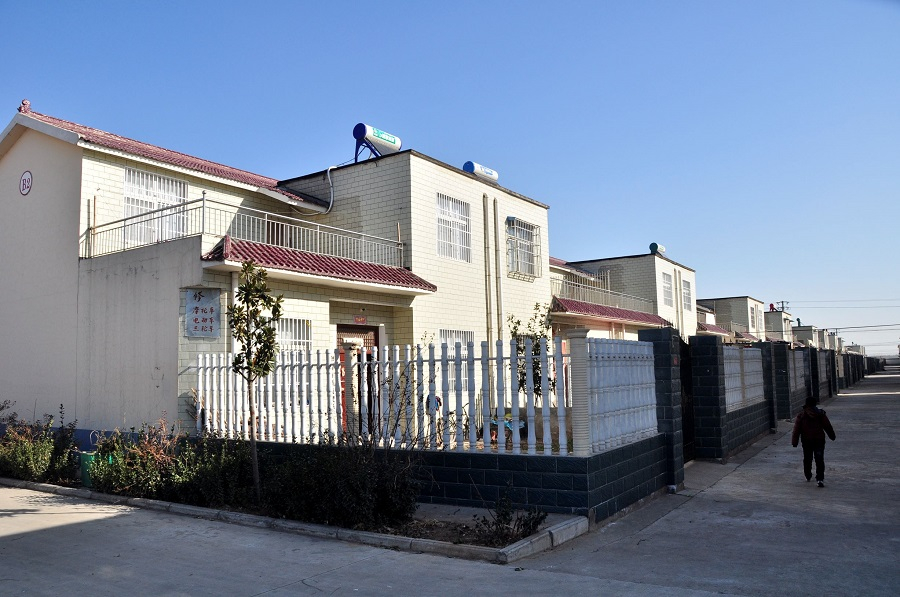Water scarcity has long hampered both livelihoods in northern China and the region’s continual development. To address this perennial problem, China has launched a South-to-North Water Diversion Project (南水北調戰略工程) to divert the plentiful water of the Yangtze River (Changjiang) (長江) from southern to northern China via a network of “four transverse and three longitudinal waterways” (四橫三縱), which entails constructing three water diversion routes (the Eastern, Central and Western Routes) to connect four major rivers (the Yangtze River, the Yellow River (Huanghe) (黃河), the Huaihe River (淮河) and the Haihe River (海河). Over time, however, the Project has given rise to a string of problems that have in turn sparked widespread debate in society.
On December 12, 2014, Beijing residents turned on the tap just like they did every day. Little did they know, this tap water would be different from that which they had had before for, from that day onwards, a major portion of Beijing’s water would originate from Danjiangkou Reservoir (丹江口水庫) located over 1,000 km away in the Yangtze River Basin. Also from that day onwards, Beijing would finally enjoy a brief respite from its dire water shortage woes.
This was possible thanks to a national key strategic infrastructure project – the South-to-North Water Diversion Project.
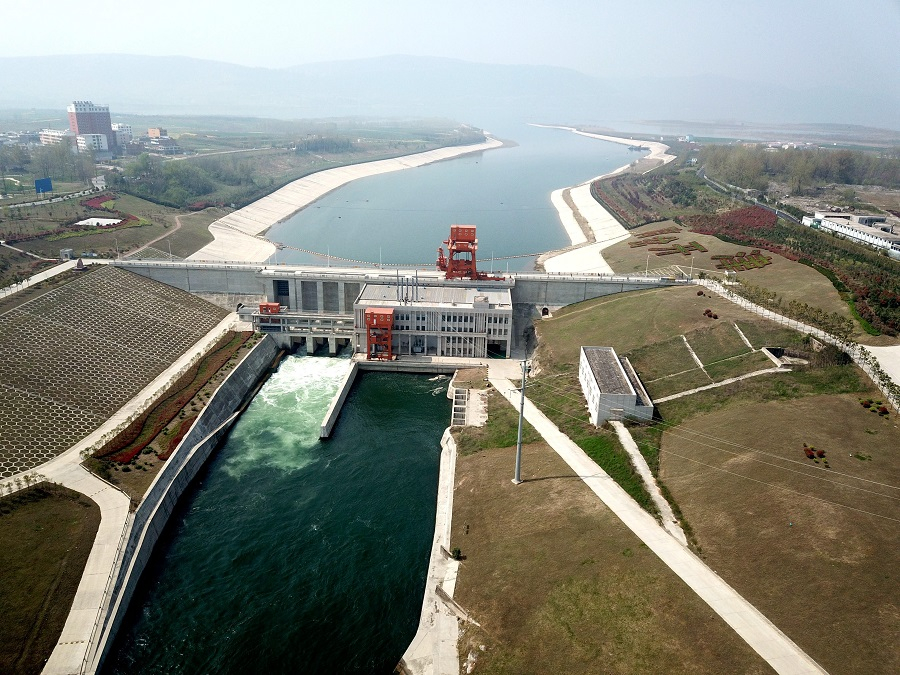
Concept
The distribution of water resources in China – abundant in the humid south and scarce in the arid north – is shaped by its geography. While the region south of the Yangtze River Basin possesses 81% of the nation’s total water resources and often suffers from flood disasters during the high-flow periods in the summer season, the region north of the Yangtze River Basin has just a scant 19% of China’s water resources, yet supports the livelihoods of around half of the nation’s population.
In the past decades, the ever-increasing demand for water, fueled by rapid economic growth, has exacerbated the water shortage in the north into a crisis. In the Huabei (North China,華北) region, nine provinces and municipalities face “absolute water scarcity”, defined as having less than 500 cubic metres of water available per person per year based on the international Water Stress Index; Beijing, the capital, has a water availability of less than 100 cubic metres per person per year.
Large-scale extraction of groundwater commenced from the 1970s onwards. As surface water resources dwindle, the actual volume of groundwater extracted often exceeds the aquifers’ capacity in many regions. The provinces and municipalities Tianjin, Hebei, Shandong and Beijing in particular have groundwater exploitation rates that are over 100%, meaning that apart from freshwater, they are also extracting slightly saline water (with salinity of 1-3 grams/litre) and moderately saline water (with salinity of 3-5 grams/litre). Long-term consumption of such water could adversely impact health; also, overdraft of groundwater could cause a host of geological and environmental hazards such as large-scale land subsidence, formation of cones of depression, seawater intrusion and land salinization.
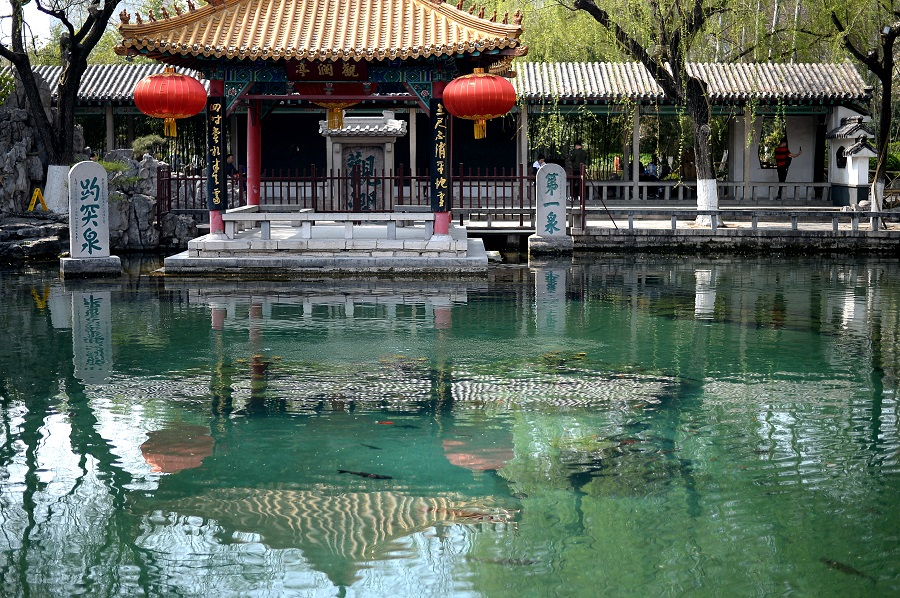
To address the uneven distribution of water resources in the north and south, the Government and experts began to explore ways to divert the south’s ample water resources to the north. A comprehensive evaluation of the South-to-North Water Diversion Project was launched in 1995. After decades of study, the Project’s overall layout was finalized and comprises three routes - the Western Route, the Central Route and the Eastern Route – to divert water from the upper, middle and lower reaches of the Yangtze River Basin respectively. In 2002, the State Council officially approved the master plan for the South to North Water Diversion Project (南水北調工程總體規劃) and construction of the Eastern Route commenced in the same year. Work on the Central Route began in the following year.
Construction
Throughout the project, the construction crew had to overcome numerous critical challenges such as the Yellow River Crossing Tunnel Project (穿黃工程) of the Central Route Scheme and the difficult terrain of the Eastern Route Scheme. When water diverted from the south flows near Xinyang City (滎陽市), Henan (河南), it must overcome the Yellow River’s flow direction and silt barriers to cross over to the Yellow River’s northern bank. To accomplish this, the construction crew bored two 4,250 metre-long tunnels under the Yellow River itself. The tunnels were designed with a dual-layer structure, with lined inner and outer layers to withstand water pressure within and outside the tunnel respectively. The works took 9 years of toil to complete. For the Eastern Route Scheme, since its water intake point near Yangzhou (揚州) is at an elevation some 40 meters lower than Shandong (located along the Route), 13 cascade pumping stations were installed along the Route to transfer the water to higher ground step by step with the help of 160 massive pumping stations.
Besides these difficulties, wastewater treatment has turned out to be an even thornier issue. Jiangsu and Shandong, two provinces traversed by the Eastern Route Scheme, are both economic powerhouses and relatively heavy water polluters. Prior to the commencement of the project, the water quality of the Jing-Hang Grand Canal (京杭大運河) was already classified as Grade V+ by national environmental standards, meaning that it was severely polluted and unfit for any purpose. Clearly, transferring such water to the north would be unacceptable. At the project scrutinization stage, China established the principle of “cleanup first, delivery later” and committed to ensuring much of the Grade V and Grade V+ water along the project route reached potable standards within ten years. During the project, Jiangsu Province spent 11 billion yuan to complete 102 pollution control projects, establishing 9 wastewater treatment plants in Xuzhou City (徐州) alone. Nansi Lake (南四湖), located along the Eastern Route, is also the hub of Shandong Province’s paper manufacturing industry. To curb pollution discharged by this industry, Shandong Province shut down several hundred paper manufacturing enterprises that had failed to meet environmental standards, and worked with scientific research institutions to reduce enterprises’ effluent to levels tolerable to fish. Ultimately the paper manufacturing industry in Shandong was forced to restructure. Water quality monitoring stations will also be set up along the Route once the project has been completed to ensure water remains clean.
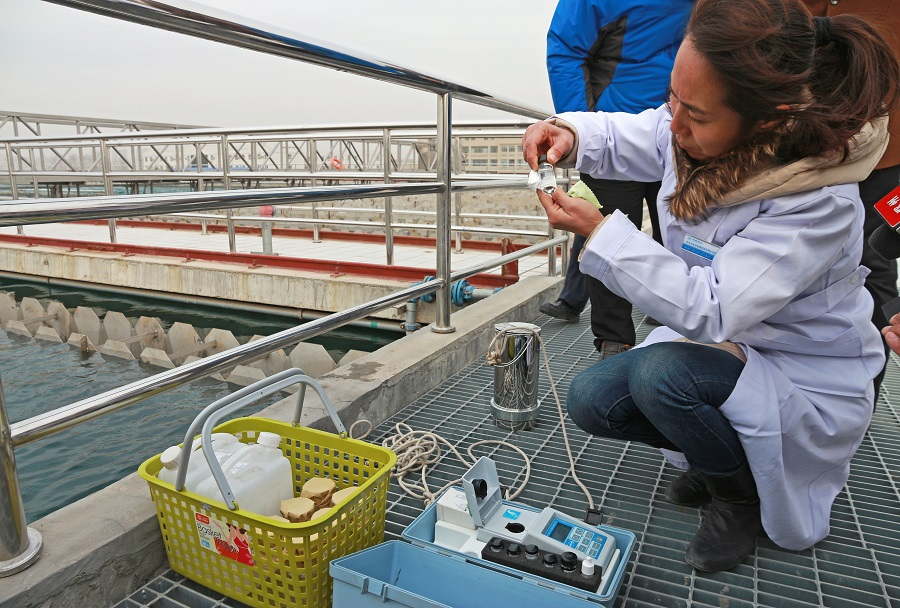
Linking the Yangtze River, the Yellow River, the Huaihe River and the Haihe River with the three water diversion routes, the South-to-North Water Diversion Project will create an overall layout consisting of “four transverse and three longitudinal waterways” as core components. The project, to be completed over the course of 50 years in three phases, will gradually raise the volume of diverted water to 44.8 billion cubic metres per year.
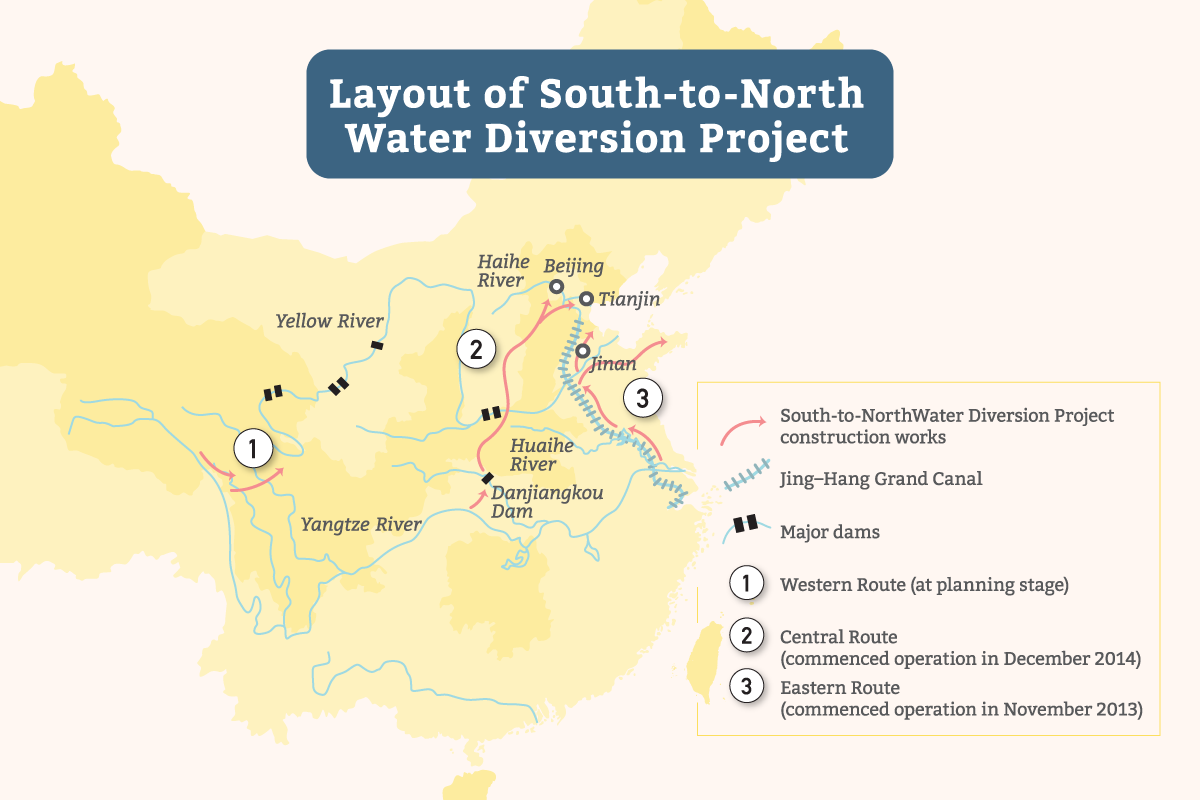
The Eastern Route Scheme draws water from the lower reaches of the Yangtze at Yangzhou, and lifts the water up in cascades northward via the Jing-Hang Grand Canal and another canal that runs parallel to it. The route connects four lakes that ensure water storage and regulation purposes – Hongze Lake (洪澤湖), Luoma Lake (駱馬湖), Nansi Lake (南四湖) and Dongping Lake (東平湖); from Dongping Lake, the Route bifurcates with one branch crossing the Yellow River to reach Tianjin, and another heading east to deliver water to Jiaodong Peninsular (膠東半島). The Eastern Route took ten years to complete and officially began operations in October 2013.
The Central Route Scheme draws water from Danjiangkou Reservoir (丹江口水庫) on upper Hangjiang (漢江), a tributary of the Yangtze. Departing via the sluice gate at Taochaqushou (陶岔渠首) located in Xichuan (淅川) County of Nanyang City (南陽), Henan, the water traverses river basins of the Yangtze, Huaihe River, Yellow River and Haihe River, suppling water along the way by means of gravity-fed multilevel and crisscrossing conduits before reaching Beijing and Tianjin. The Central Route commenced operation in December 2014.
The Western Route plans to construct reservoirs on Tongtian River (通天河), the upper section of the Yangtze, as well as headwater tributaries, the Yalong River (雅礱江) and the Dadu River (大渡河). In addition, a tunnel will be bored through Bayan Har Mountains (巴顏喀拉山), which is the drainage divide between the Yangtze and the Yellow River, to allow Yangtze water to enter upper Yellow River. Due to its technical complexity and high construction cost, the Scheme is still in the planning stages.

Controversies
As a national strategic project involving multiple issues and stakeholders, the South-to-North Water Diversion Project has been surrounded by controversy from day one, stirring emotions concerning environmental, economic, social and other issues.
There are concerns that diverting water from the Yangtze would affect the river’s existing downstream ecosystems, particularly at periods of inadequate discharge such as the dry season and low-flow periods, causing saltwater intrusion at its delta in serious cases. Zhang Jiyao (張基堯), the then Director of the South-North Water Diversion Project Office (南水北調工程建設委員會辦公室) of the State Council, addressed such concerns by explaining that such a situation would not occur as the Yangtze’s annual discharge is around 960 billion cubic metres and the total amount of water to be diverted by the South-to-North Water Diversion Project would be 44.8 billion cubic metres, less than 5% of the annual discharge, and thus would not affect the total discharge. At low-flow periods, water could be released from dams along the routes to replenish the Yangtze. Cao Wenxuan (曹文宣), a member of the Chinese Academy of Sciences (中科院) has pointed out that the South-to-North Water Diversion Project would have a significant impact on aquatic life in the Yangtze. Changes in the river’s water temperature and other hydrological characteristics would affect fish behaviour and in turn affect plankton, fish larvae and aquatic plants along the food chain. Such changes were observed after the completion of the Three Gorges Dam but an assessment of their impact has been inconclusive so far. Further studies are necessary.
There are also concerns that the massive investment and high costs required to implement the South-to-North Water Diversion Project would lead to a corresponding increase in water prices in the north. According to the South-North Water Diversion Project Office, while water prices would inevitably rise, construction costs of the South-to-North Water Diversion Project would be subsidized by the government as it is a national strategic project. Thus any increase in water tariffs would solely be for system maintenance and would be kept within residents’ bounds of affordability. In practice, however, while the main works would be nationally funded, local governments would be responsible for building ancillary systems with funds from their own coffers. This would inevitably affect the total amount of tariffs payable in various regions, and might account for the lukewarm reception of the project from some local governments, as well as the variations in additional water tariffs levied in different regions.
Relocation remains the most controversial issue concerning the South-to-North Water Diversion Project. To increase the storage capacity of Danjiangkou Reservoir, the water source of the Middle Route, some areas along the route had to be flooded, requiring the relocation of over 300,000 residents in affected areas of Hubei and Henan provinces. The government had to build new homes and allocate farmland for the people displaced, as well as issue payments for relocation, land, buildings and other compensation items. The actual implementation, however, was far more complicated. First of all, many displaced residents had to change their livelihood activities from cultivating fruit trees and fishing (originally practiced by many residents of the reservoir area), for example, to rearing livestock and growing food crops. This posed a significant challenge to many relocated farmers, and the compensation they had received from the government was, after all, limited. Secondly, besides dealing with the challenges of relocation physically, the people relocated suffered from significant psychological trauma. Traditionally, Chinese culture attaches great importance to families being “rooted” in their land, village, town over many generations. The elderly residents who had lived in Danjiangkou for many years, in particular, found it tough to cope with the disruptive moving experience and the tumultuous changes to their living environment. Many found it difficult to adjust to a new lifestyle, grew nostalgic and wished to return to their homeland. Relocation is a dilemma for hydraulic projects worldwide, and governments are challenged to deal with the competing demands of the greater good of water security for many and safeguarding relocatees’ rights, resettling them successfully, and addressing the social and psychological problems arising from relocation.
Outlook
The South-to-North Water Diversion Project serves many useful purposes: mitigating floods in the Yangtze region, supplying northern China with reliable, clean water that would allow the region to urbanize, unfettered by water shortages. It would create a better environment for the livestock industry, improve use of land and promote agricultural development in the north. Moreover, it will improve the environment and benefit the ecology in the north by replenishing groundwater, curbing the fall of groundwater tables and preventing groundwater depression cones from expanding further, while maintaining the health of riparian ecosystems.
Though the South-to-North Water Diversion Project has enhanced the water supply, it does not justify using water in a wanton and thoughtless manner. Water users must try to conserve and use the resource prudently by adopting appropriate conservation measures, for example by exploring the treatment and reuse of greywater in cities, changing existing irrigation practices that use water inefficiently, and so on. This will be the best way to show reservoir residents displaced by the Project that we are worthy of their great sacrifice, as well as paying due respect to water for being the source of all life.
Related video:
Water Pulse (documentary) -China Central Television
References:
South-to-North Water Diversion Project Report Part 2: Relocation (南水北調系列報道之二:移民篇 ) Minsheng Weekly (民生周刊) 2014, Volume 16
330,000 People Relocated because of South-to-North Water Diversion Project Middle Route Unable to Rebuild with Compensation (南水北調中線移民近33萬 補償款不夠建房) tencent.com Feb. 23, 2010
Policy-Makers Remark: Six Questions about the South-to-North Water Diversion Project (決策者說:六問南水北調工程) China Central Television Dec. 21, 2005
Protecting the Yangtze’s Ecosystem: Last Chance (保護長江生態:最後的機會) lwdf.cn Dec. 17, 2013





